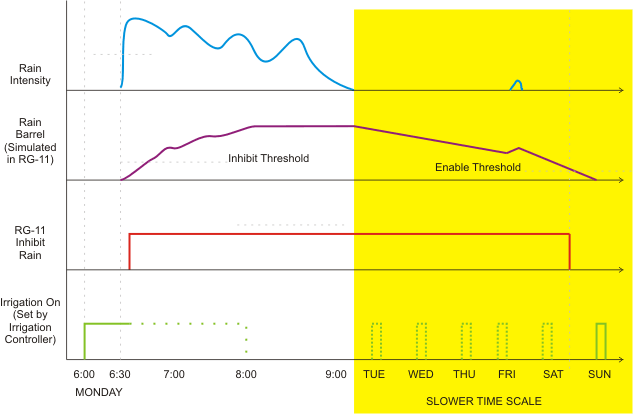Inhibit During Storm: The RG-11 normally inhibits irrigation during a rain-storm, even though not much water has accumulated yet. The reasoning is that if it is raining hard now, it is most likely that enough water will accumulate, and we do not want to waste water. The "inhibit during storm" feature may be defeated by turning on DIP switch 4.
Inhibit During Freeze: Normally the RG-11 will also inhibit irrigation if the temperature of the sensor drops below about 34 degrees. This is to prevent the irrigation system from covering everything with a coat of ice. You can defeat "inhibit during freeze" by turning on DIP switch 5.
Soil Water Modeling: The computer in the RG-11 models the water stored in the soil, and uses this to inhibit or enable irrigation. Sensed rain is accumulated in a software "Rain Barrel". When the the amount of rainwater accumulation reaches a threshold, the RG-11 inhibits the sprinkler system. The amount of rainwater that may accumulate in the Rain Barrel is limited to a "Barrel Size" to simulate the effects of soil saturation. If more rainwater than this falls, it runs off and is not used by the groundwater anyway. The accumulated water "evaporates" at the rate of 0.11" inches per day. Once the accumulated water decreases to the turn-on threshold, irrigation is re-enabled.
Each of the irrigation control parameters are adjustable in software with DIP switches.
| Setting | Inhibit Threshold | Enable Threshold | Barrel Size | Max Inhibit Days |
| Normal | 0.25" | 0.10" | 0.66" | 5 |
| Water more | 0.37" | 0.20" | 0.64" | 4 |
| Water a lot more | 0.50" | 0.30 | 0.63" | 3 |
| Water less | 0.12" | 0.01 | 0.67" | 6 |
| Water a lot less | 0.06" | 0.01 | 0.78" | 7 |
Irrigation Control Example:
The graph below illustrates how the RG-11 controls irrigation:

- At 6:00 AM on Monday, the irrigation controller calls for water, shown by the green line on the above graph. The zone valves dutifully open and the sprinkler heads start watering the lawn. The sky is dark with heavy rainclouds, but it has not yet started raining.
- At 6:30, it starts raining and it quickly becomes a downpour. The RG-11 detects the downpour and inhibits irrigation, shown on by red line on the graph. The RG-11 interrupts the current to the zone valves, and the irrigation water stops. The irrigation controller is still calling for more water, but this is ignored, shown by the dashed green line.
- The neighbors have a disk-style rain sensor, but this has not yet accumulated enough water to shut off their system, and their sprinklers continue during the downpour.
- By about 6:45, the Rain Barrel accumulation in the RG-11 reaches the inhibit threshold. That is, enough water has accumulated that the RG-11 would inhibit the system even if the "inhibit during rainstorm" feature were disabled.
- It continues to rain hard and steady, and the RG-11 continues to record the amount of water accumulated in the simulated Rain Barrel.
- By 8:00, so much water has accumulated that the soil is saturated. The pouring rain that continues now runs off the soil and into the storm sewers. The RG-11 stops recording additional accumulation in Rain Barrel.
- At about 9:15 the storm stops.
- Over the next several days, on Tuesday through Friday, the RG-11 slowly decreases the amount of water recorded in the Rain Barrel, shown has the purple line slowly decreasing. Each morning, the irrigation control calls for more water, but this is properly inhibited by the RG-11. The lawn received more than enough water for this time period on Monday.
- On Friday afternoon a short summer shower rolls through. This is enough to add a bit more moisture to the soil, which has not yet fully dried out. The RG-11 records this in Rain Barrel, extending the time it inhibits irrigation.
- In mid-afternoon on Saturday, the accumulated water in Rain Barrel has decreased to below the turn on threshold. The lawn has used up most of the water stored in the soil. The RG-11 stops inhibiting irrigation.
- On Sunday morning, the irrigation controller calls for irrigation. By this time the soil is dry enough to need it, and sprinkler heads deliver the proper amount of water
